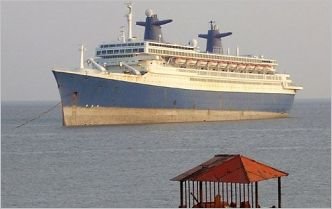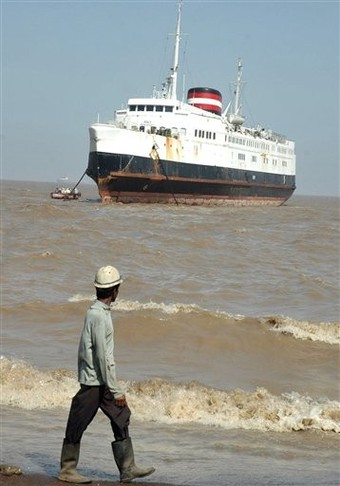Note: Some 120 ships are currently standing on once pristine Alang beach. The hazardous industrial operations in this fragile coasatal environment began in the early eighties in the pre-Environment Protection Act, 1986 era. It is about time Alang beach taken away from the vice like grip of ship owning companies and countries and is restored to its earlier glory.
Danish companies have strong stake in ship-breaking in Alang, Gujarat and they pursue goal of dumping hazardous wastes by mutilating Basel Convention and by supporting International Maritime Organisation (IMO) Convention on Shipbreaking calling it recycling.
It may be recalled that the Danish ship “Ricky” (51 year-old asbestos laden ship, Kong Fredrick IX) contained hazardous wastes entered Alang beach for scrapping ilegally as it was bought by Jupiter Ship Management, a Mumbai based company. On 15 April, 2005, Connie Hedegaard, Denmark's environment minister alerted her Indian counterpart A Raja about the illegal movement of this ship. Ricky ('Kong Frederik IX') left Denmark on 16 March 2005. One wonders as to why did it take one month for the Danish Minister to alert the Indian auhtorties? What is the fate of the case that was filed against the original ship owner in Denmark? Letters were sento Danish authorties but no reply was recieved.
Per Stig Moller, the then Danish Minister of Foreign Affairs also wrote to K Natwar Singh, the then Indian Foreign Minister. This was followed-up by meetings between Michael Sternberg, the then Danish ambassador in Delhi and the Pradipto Gosh, the top bureaucrat and Secretary at the Indian Ministry of Environment and Forests (MoEF).
On 23 April 2005, "Riky" arrived for scrapping at Alang under the jurisdiction of Gujarat Maritime Board. Even the flag under which the ship sailed in isn't perfectly clear. N B Deshmukh, the then Assistant Commissioner, Customs Division, Bhavnagar, Gujarat said that Riky was carrying the flag of Democratic Peoples Republic of Korea (North Korea). An application was filed in 2005 challenging the MoEF in the Supreme Court on the ship's admission into India because the ship sailed in under the flag of Roxa, a non-existent "country". The case is till pending in the Supreme Court.
Ship owning countries and compnies are using IMO Convention to make such state of affairs legitimate. If that happens Alang will practically be deemed a place outside the jurisdiction of Government of India.
Is it wild to draw a possible link between India's best kept secret of the night when arms rained over Purulia in Bengal at night on 17th December, 1995 and Alang's ship breakers with business relations with Danish enterprises?
The next date of listing of the hazardous wastes case is 5th August, 2011.
Gopal Krishna
ToxicsWatch Alliance (TWA)
The Supreme Court bench of Justice G.S. Singhvi and Justice C.K. Prasad expressed concern over the environmental impact of dismantling and recycling of foreign ships carrying radioactive material and other toxic wastes at Alang port in Gujarat.
The apex court wished to know as to why these ships were not dismantled or broken in the country of their origin. Justice Singhvi said that tonnes of toxic waste was being brought to Alang port and dumped there.
The court said that recycling and breaking of ships at Alang port could be beneficial for some people in Gujarat or in other states but it was adversely impacting the environment.
"Why don't they break these ships in their own countries," Justice Singhvi asked.
The court made it clear that it would not be an indifferent spectator if there was any adverse bearing on the environment because of ship recycling activities. "If there is a threat to environment, then this court will intervene," said Justice Singhvi.
The court's observations came in the course of the hearing of a petition by Alang port-based Ship Recycling Association (India) seeking direction to Gujarat Maritime Board (GMB) not to go ahead with the auction of four plots each measuring 120 square metre.
The association asked the court to direct the board to first implement the recommendation of the committee of technical experts which said that smaller plots of 30 square metre each should be merged to create bigger plots as the smaller plots were not suitable for carrying out ship recycling activities.
The association told the court that the board accepted the recommendation of the committee and decided in favour of larger plots by phasing out the existing smaller plots.
The association sought orders restraining the board from auctioning the four plots without first merging the existing smaller plots to create bigger plots. The court declined the plea.
The court dismissed the application by the association.
The order dated 25/05/2011 by the (VACATION BENCH) is as under:
UPON hearing counsel the Court made the following
O R D E R
In this application filed by Ship Recycling Association (India), prayer has been made to restrain the Gujarat Maritime Board (for short, 'the Board') from auctioning the four vacant plots measuring 120 square meters at Alang Ship-Recycling Yard and to direct the Board to amalgamate and/or convert the existing smaller plots measuring 30 square meters into bigger plots before auctioning the four vacant plots.
While, learned counsel for the applicant heavily relied upon the recommendations made by the Standing Monitoring Committee on Ship Breaking Yard at Alang which is said to have recommended for merger of the available plots with the smaller plots, learned counsel representing the Board submitted that in view of the provisions contained in the Gujarat Maritime Board Act, 1981 (for short, "the Act"), the Gujarat Maritime Board (Conditions and Procedures for Granting Permission for Utilising Ship Recycling Plots) Regulations, 2006 (for short, "the Regulations") and the policy framed by the Board for amalgamation/merger of the existing plots, the smaller plots on which the members of the applicant association are carrying their operations, cannot be merged with the four plots proposed to be auctioned. Learned counsel also produced site map to show that the plots proposed to be auctioned are far away from the 30 square meters plots and argued that the same cannot be amalgamated or merged with the smaller plots.
We have considered the respective submissions and carefully perused the documents on which reliance has been placed by learned counsel for the parties. We have also gone through the provisions of the Act and the Regulations as also the guidelines framed by the Board for amalgamation of the plots.
In our view, the prayer made by the applicant is thoroughly misconceived and there is no valid ground, much less, justification for restraining the Board from auctioning the four plots or for issue of a direction for conversion of the existing smaller plots into bigger plots by adding portions of the four plots with the smaller plots. Although, there is some dispute between the parties about the exact distance between the smaller plots on which members of the applicant association are carrying their operations, they are ad idem that two kinds of plots are situated at some distance. The Regulations framed by the Board in exercise of the power conferred upon it under Sections 37, 38, 39, 41 and 110 of the Act and Clause-A of the guidelines do not permit for amalgamation of the plots by shifting the existing plots to another plot location.
The guidelines also prohibit amalgamation of two working plots. In terms of sub-clause (2) of Clause-A, the vacant plot located in between two working plots having 30 square meters width can be offered to both adjoining plot holders in equal measure. However, there is no provision for amalgamation of larger plots with the smaller plots irrespective of the distance between two plots. Therefore, there is no warrant for staying the auction of the four plots measuring 120 square meters or for issue of a direction to the Board to merge portions of the bigger plots with the smaller plots.
In the result, the application is dismissed.
This group tracks the responses of shipping industry towards environmental and occupational health justice, highlights influence of shipping companies from EU, US and Japan etc. on IMO, its Marine Environment Protection Committee and South Asian governments. It is keen to restore beaches in India, Bangladesh and Pakistan to their pristine glory for the coming generations. For more information visit: www.toxicswatch.org
26/05/2011
Subscribe to:
Post Comments (Atom)










No comments:
Post a Comment